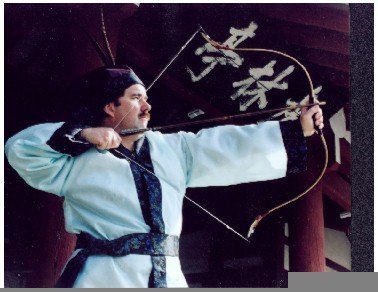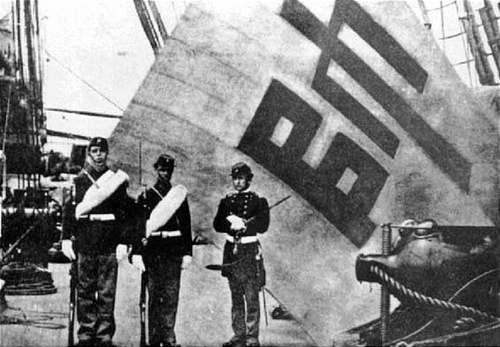American campaigns for flag’s return
Published : 2010-10-29 09:39:37
After almost 12 years of effort, one American’s quest to see an artifact of conflict returned to Korea achieved fruition three years ago.
Now he seeks to make that victory permanent.
Thomas Duvernay, a 49-year-old associate professor at Yeungnam University in Gyeongsan, North Gyeongsang Province, has been campaigning for the return of a Joseon general’s flag, captured by the U.S. during the first military action between the Joseon Dynasty and the United States in 1871.
His decade of behind-the-scenes efforts paid off when the war prize, Sujagi, returned to its motherland in 2007. The U.S.’s term of return, however, was a 10-year loan. Duvernay has continued at forefront of efforts to make the return of the flag permanent.
Sujagi, captured by U.S. Naval forces, had belonged to the Commander of Korean forces, General Eo Jae-yeon (1823-1871), who died at the battle of the Gwangseongbo fortress in Gwanghwado during the military action, which is referred to as Shinmiyangyo.
Now he seeks to make that victory permanent.
Thomas Duvernay, a 49-year-old associate professor at Yeungnam University in Gyeongsan, North Gyeongsang Province, has been campaigning for the return of a Joseon general’s flag, captured by the U.S. during the first military action between the Joseon Dynasty and the United States in 1871.
His decade of behind-the-scenes efforts paid off when the war prize, Sujagi, returned to its motherland in 2007. The U.S.’s term of return, however, was a 10-year loan. Duvernay has continued at forefront of efforts to make the return of the flag permanent.
Sujagi, captured by U.S. Naval forces, had belonged to the Commander of Korean forces, General Eo Jae-yeon (1823-1871), who died at the battle of the Gwangseongbo fortress in Gwanghwado during the military action, which is referred to as Shinmiyangyo.

Since then, the United States Naval Academy Museum in Annapolis, Maryland has cared for the flag. As the museum’s exhibits grew and space diminished, the flag was eventually rolled up and placed on the bottom shelf of a display case.
“Except for a small card, you would not have known what it was,” Duvernay told the Korea Herald.
He felt that an anonymous existence for the Sujagi was a pity, especially since in Korea it would be given a display of its own.
His membership at the Korean archery club, Horim Jeong, has drawn him to learn the history of Korea. His research into the bows and arrows used militarily in Korea eventually led him to the story of Shinmiyangyo.

When Western countries sought to expand their spheres of influence in Asia in the 19th century, the General Sherman, an American-owned but British-leased ship, sailed up the Daedong River toward Pyongyang and was eventually destroyed in 1866.
Korean history books associate the destruction of the General Sherman with the Shinmiyangyo, but Duvernay said the two events are “really not related.”
“The official U.S. records of 1871 mention nothing about the General Sherman in connection with the Shinmiyangyo,” he said.
In 1871 Joseon was under the rule of King Gojong, who operated a closed-door policy. Duvernay notes “the Americans and Korean civilians initially got along, but soon changed after the Joseon government decreed that its citizens have no contact with the outsiders.”
As a result, when Americans wished for trade, the Koreans said nothing, which the Americans took as agreement; however, the Koreans’ silence actually meant disagreement, the scholar said.
After the misunderstanding, American gunboats and cutters, which could sail up the shallow straits, were fired upon by Korean shore batteries.
Soon, American naval landing parties went from fort to fort destroying what they could. After two weeks, American troops fired on Koreans with their modern cartridge firearms, while the Koreans fired back with their obsolete matchlock muskets at the Gwangseongbo Fortress in Gwanghwado.
“That was when the Commander of Korean forces, General Eo Jae-yeon, died and his standard, the Sujagi, was captured,” he said.
Soon after he discovered this historical event he called all over -- from the director of the USNA’s museum to the presidents of the U.S. for 12 years. He recounted that the answer was always the same: The flag was put into U.S. possession by a presidential decree and could not be removed without an Act of Congress.
Hence, he suggested what his close friend, Colonel Kim Ki-hoon, a history professor at the Korea Military Academy, suggested -- a museum-to-museum loan to Korea’s Cultural Heritage Administration.
In 2007, agreement was reached on a long-term loan of the flag back to Korea, and the Sujagi eventually came home and was unveiled to the public
Nevertheless, Duvernay wants the flag returned permanently. “First of all, the flag itself was owned by Korea,” he said. Secondly, as two nations now have cordial relations, for the U.S. to keep the flag “is like a friend withholding a friend’s asset,” he added.
“The U.S. had returned the Iwo Jima islands to Japan that led to 7,000 U.S. casualties during the Pacific war. Which means there is no reason for U.S. to not return an old flag to its mother country where they only lost four sailors and marines at the related battle.”
Aside from the returning of the flag, Duvernay has been working on relations among the descendants of the Shinmiyanggyo veterans. A few years back, he invited James Wardrop, a descendant of one of the four casualties at the battle, to meet with Eo Yoon-won, the Korean general’s grandson, to participate in the memorial rites. “James Wardrop and Eo got along well with each other and became friends,” he said.
Now that the flag has been in its homeland for three years out of the 10-year loan, he said “we need to put every effort into getting the permanent return of the flag.”
On the differing historical information on both countries of Shinmiyangyo, he said, “Look from both sides, and try not to be inclined to one side, because the incident itself was aroused due to misunderstanding of each other in the first place.”
“Only when the Koreans fully understand the meaning of the Sujagi will the flag return permanently.”
By Hwang Jurie (jurie777@heraldcorp.com)
http://www.koreaherald.com/common/newsprint.php?ud=20100907000799